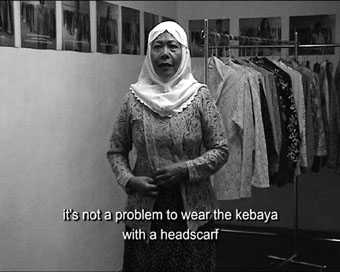The art of the Kebaya
Maurice O'Riordan
 Victoria Cattoni, Through the Kebaya,
Victoria Cattoni, Through the Kebaya,
video installation performance,
Bandung, Indonesia, 2003
“We give meaning to the kebaya but the kebaya also gives meaning to us.”
Suryakusuma, JI, catalogue essay, Membaca Kebaya: Reading the Kebaya, Denpasar, Bali, 2003
The blouse-like Indonesian kebaya is a ‘doorway’ for Darwin-based artist Victoria Cattoni, an entry into the possibility and performance of a transcultural space. It is the paradoxical medium and message for her video performance-based Masters research project Through the Kebaya at Charles Darwin University. This project comprises a 5 year journey in which she mastered Bahasa Indonesian and developed a widespread program and network of collaborative performer communities. Though Cattoni explores the kebaya as a new media/installation artist, the project also makes for fascinating visual anthropology, supported by a methodology and interactive focus that would make any self-respecting anthropologist proud.
My first experience of Through the Kebaya was in Darwin in November 2002. Cattoni had returned from Denpasar, Bali, where she has spent most of the last 5 years. The wound of Bali’s ‘Black October’ bombings was still raw, with Darwin Hospital’s emergency unit working round-the-clock as the nearest port for ‘First World’ medical treatment. The gauze-like look of the kebaya evoked news footage of serious burn victims arriving at Darwin airport. Even aside from such macabre associations, the exhibition was highly charged given the temper of Indonesian-Australian and Muslim-West relations. The timing then, as now (post-Australian Embassy bombing), could not be more poignant for Cattoni’s deceptively simple vehicle for cultural affinity and critique.
Tamasya Kebaya, the initial Darwin exhibition at Charles Darwin University Gallery, established the video, performance and installation elements Cattoni later utilised in a range of workshop/exhibition venues throughout Bali and Java. According to Cattoni, these are the parts of Indonesia where the kebaya is most visible in daily life. Part of the national costume for Indonesian women (worn traditionally as the kain-kebaya, the kain being the unstitched cloth around the lower half of the body), the kebaya as a cultural phenomenon is rich in paradox. Despite its nationalist symbolism the kebaya is not pan-Indonesian. It was shaped from foreign origins, an amalgam of Arabic, Chinese and European influences dating from the 16th century. Balinese women adopted the kebaya as late as the 20th century (ostensibly under Dutch orders), but are now among its staunchest advocates, with some of the more modern, transparent Balinese variations adding to the garment’s paradoxical quality of concealment and revelation.
The revelation of Cattoni’s initial Darwin workshop and exhibition was in its discreet layering of still and moving imagery, text and performance. The workshop involved voluntary participants choosing a kebaya (or 2) from a well-stocked rack, to try on in front of a mirror, behind which was a camera. Cattoni, herself a participant-performer, was on hand to guide the process, as was a 2 minute video loop, Bali stills, which contextualised the kebaya in Balinese/Indonesian society. The edited footage of Darwinites (including Indonesians) (un)dressing and speaking to the mirror/camera was projected onto the gallery wall in the exhibition. Video stills, the video-loop and rack of kebayas completed the exhibition’s installation, with the attendance of workshop performers on opening night further magnifying the self-reflexive and multifaceted poetry of Cattoni’s project.
Each manifestation of Through the Kebaya throughout Bali and Java, and again in Darwin (2004), was a layer-building process in itself, particularly in the cumulative potency of varied workshops feeding into other workshops and exhibitions. Cattoni used the initial footage from Darwin, for example, as workshop material in Indonesia. The ‘action-based’ nature of the research, as outlined in her thesis, is fundamental to the project’s intuitive and discursive documentation, and to Cattoni’s artistic strategy. Describing herself as “an artist working outside the comfort zones of my own culture”, Cattoni’s personal readings of the kebaya matter little here. Wary of exoticising the garment, and the political climate surrounding her work, she maintains the utmost distance from the project’s ‘centre of meaning.’
It is the voices and gestures of a sizeable cast of mostly Indonesians and some Australians who give form and meaning to the kebaya—girls, women and men who share a transcultural and, to a certain degree, transgendered liminality. This is “more than an exchange of culture”, argues Cattoni; “this is culture making—it demonstrates in an emphatic way how it is we all add value, create meaning, construct identity.” The sense of ‘play’ in the process is apparent in other work by Cattoni, such as her award-winning entry in Darwin’s recent “Sculpture in the Park” exhibition, The art of buoyancy, a 2 minute film screened in a tourist shop window.
Through the Kebaya represents the first comprehensive exploration of a garment close to the heart of Indonesian femininity and sense of tradition, yet largely overlooked as a unique historical or cultural object. In the loaded realisation of her lace-brocade medium, the underlying paradox is Cattoni’s creative ‘absence.’
Victoria Cattoni, Through the Kebaya, a cross-cultural project; Indonesia and Australia (2002-2004)
RealTime issue #63 Oct-Nov 2004 pg. 54






